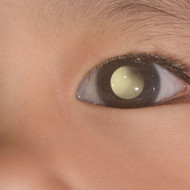What is Retinoblastoma?
7th Oct 2021

What is Retinoblastoma?
If you’re familiar with Dane’s Story you’ll know that when his cataract was discovered by our GP, she wasn’t sure whether it was a cataract or retinoblastoma. Both conditions apparently can present very similarly and an ophthalmologist was required to make the diagnoses. We were extremely fortunate that the condition Dane had wasn’t Retinoblastoma because it is far more serious than a congenital cataract.
Being such a serious condition, it's important that parents are aware of the signs of Retinoblastoma and it's another reason why having your child's eyes checked from 6 months of age is so very important.
So what is Retinoblastoma?
Retinoblastoma is an eye cancer that begins in the retina in the eye. It is most common in children, although rarely adults can also be affected. Retinoblastoma can occur in one or both eyes. The cancer can remain in the eye/s or spread to other parts of the body.

Symptoms of Retinoblastoma
Retinoblastoma can often be missed because it does affect infants and children, who typically cannot communicate the impacts of the symptoms. Some signs to be aware of for Retinoblastoma include:
- A glow – a white spot in the centre of the eye (pupil). This can most easily be seen when taking a flash photograph of the child. The medical term for this is Leukocoria
- Poor vision
- Eyes swelling/one eye bigger than the other
- Eye redness
- Eyes that appear to be looking in different directions (much like Strabismus)
What causes Retinoblastoma?
For the most part, Retinoblastoma is just like other cancers, where it forms purely by chance. However, Retinoblastoma can be hereditary, which is true for around 1 in 3 children that get the condition.
How is Retinoblastoma treated?
The main types of treatment for Retinoblastoma include:
- Surgery
- Radiation therapy
- Laser therapy
- Cryotherapy
- Chemotherapy
Any childhood cancer can be extremely frightening but the good news is that overall, more than 9 in 10 children with Retinoblastoma are cured. The aim of treatment is to remove the cancer and save the child’s life, save the eye and get as much vision as possible, and to limit the risk of side effects for later life as a result of treatment.
If you are concerned about your child experiencing any possible symptoms of Retinoblastoma – or any other eye condition – see your GP straight away.
For more information about Retinoblastoma, check out Know the Glow
Sources : Cancer Australia, American Cancer Society

